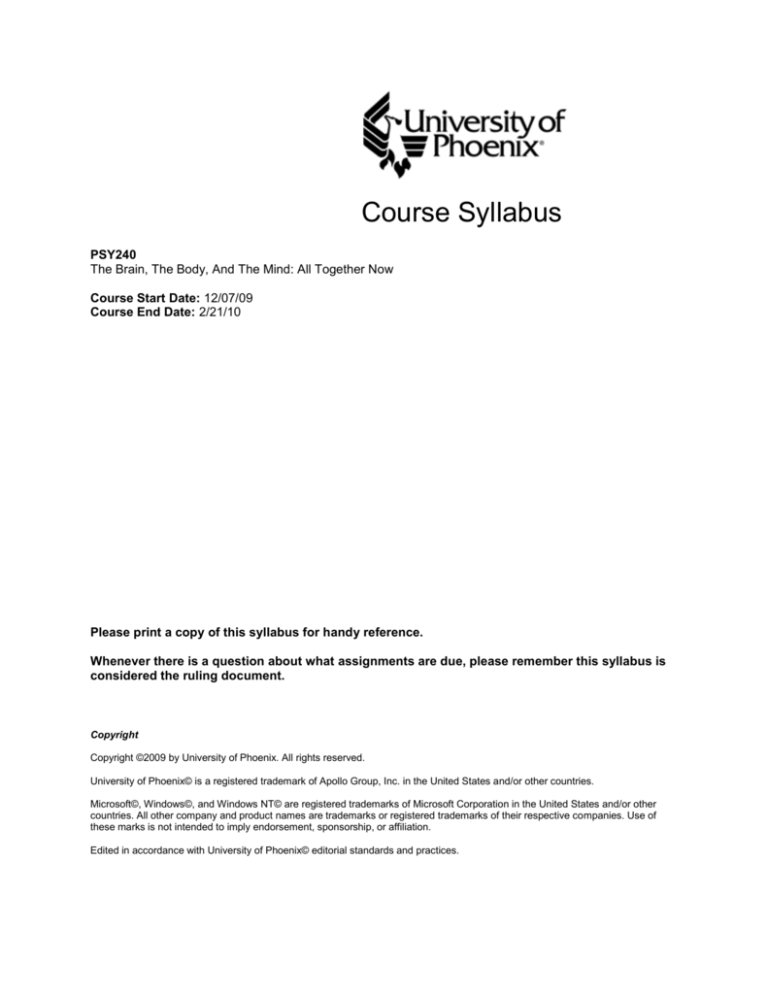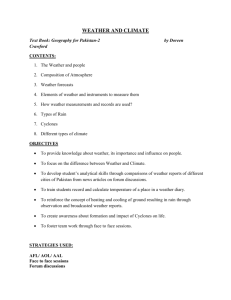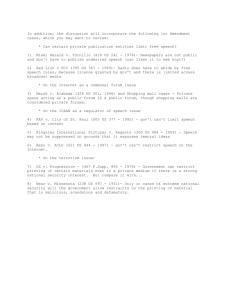
Course Syllabus
PSY240
The Brain, The Body, And The Mind: All Together Now
Course Start Date: 12/07/09
Course End Date: 2/21/10
Please print a copy of this syllabus for handy reference.
Whenever there is a question about what assignments are due, please remember this syllabus is
considered the ruling document.
Copyright
Copyright ©2009 by University of Phoenix. All rights reserved.
University of Phoenix© is a registered trademark of Apollo Group, Inc. in the United States and/or other countries.
Microsoft©, Windows©, and Windows NT© are registered trademarks of Microsoft Corporation in the United States and/or other
countries. All other company and product names are trademarks or registered trademarks of their respective companies. Use of
these marks is not intended to imply endorsement, sponsorship, or affiliation.
Edited in accordance with University of Phoenix© editorial standards and practices.
Facilitator Information
RaTonya Bennett, LPC
rrbennett@email.phoenix.edu (University of Phoenix)
rbennett08@hotmail.com (Personal)
318-219-6212 (CST)
Facilitator Availability
Hello Class,
I am usually available after 6 pm, CST during the week in your classroom to participate and answer
questions. I generally will be offline on Fridays and Saturdays. If these times are not convenient for you,
please let me know, and I will be happy to accommodate your schedule if at all possible. I provide you
with these times to make it easier to communicate with me, not to limit our contact and want you to know
that, should you need to contact me outside these time frames, you should not hesitate to do so. If you
post a question to your Individual Forum I will respond to you the next time I check into class, with a goal
of responding within 24 hours!
If you would like to speak by phone you may certainly call me. To ensure you reach me, please post a
request for phone communication in your Individual Forum to set up a time for you to call me. I am here to
help you succeed in any way I can.
For emergencies, when you are not able to gain access to messages on the Online Learning System
(OLS), please send a message to both of my email addresses.
For emergencies, when you are not able to gain access to messages on the Online Learning System
(OLS), please send a message to my personal email address. In the event a third party needs to contact
me, please direct them to my contact information listed under "facilitator information." No third party
should use your login credentials to gain access to the classroom.
For emergencies, when you are not able to gain access to messages on the Online Learning System
(OLS), please send a message to my personal email address. In the event a third party needs to contact
me, please direct them to my contact information listed under "facilitator information." No third party
should use your login credentials to gain access to the classroom.
For emergencies, when you are not able to gain access to messages on the Online Learning System
(OLS), please send a message to my personal email address. In the event a third party needs to contact
me, please direct them to my contact information listed under "facilitator information." No third party
should use your login credentials to gain access to the classroom.
Where to Go to Class
Main: This is the main forum for the class and is where discussion is conducted. It has read-and-write
access for everyone.
Chat-Room: This is a read-and-write access forum. It is designed as a place to discuss issues not related
to the course content. This is the forum to which we will send our bios.
Course-Materials: This is a read-only forum, which means you can read messages here but cannot send
any. This is where I will post the course syllabus and materials.
Individual Forum: You will see one forum with your name on it. This is a private forum, shared only by
you and me, the facilitator. Your classmates will not have access to this forum. This is where you will post
your individual assignments, and where I will post your feedback. You can also ask questions here.
However, if you have general questions about instructions of assignments, please post those in the Main
forum, since other students may benefit by that exchange as well.
Policies
For class policies, please see the Policies link on the left side of the Materials page for the course on
eCampus. Faculty and students/learners will be held responsible for understanding and adhering to all
policies contained within that link. University policies are subject to change so please be sure to read
them at the beginning of each class as it may have changed since your last class. Policies may be slightly
different depending on the modality in which you attend class. If you have recently changed modalities it
is important you read the policies governing your current class modality.
Technical Support
Technical Support is available 24 hours a day, 365 days a year. Call 1-877-832-4867, or use the e-mail
support form.
Answers to the most common issues are found in the Knowledge Base by clicking Help, found at the top
of every student Web site.
Feedback
Each week, I will provide grades or scores and comments on your assignments. I will send feedback to
your Individual forum.
Grading Formula
Points Grade
95+
A
90-94
A-
87-89
B+
84-86
B
80-83
B-
77-79
C+
74-76
C
70-73
C-
67-69
D+
64-66
D
60-63
D-
<59
F
Course Description
This course provides an introduction to the investigation of physiological and neurological basis for
human behavior. The student will be able to study and discuss various influences on personality
development, such as pre-natal maternal behavior; gender; nature versus nurture; brain development;
genetic composition; sensory motor interactions; learning disabilities; drug impacts; and neurological
diseases.
Course Topics & Objectives
Week One: Introduction to Biopsychology
Describe the biopsychology and its theoretical framework.
Explain the affects of behavior on evolution.
Explain the concepts behind the nature versus nurture issue.
Week Two: The Brain and Nervous System
Identify the structures of the nervous system and brain.
Summarize the biological functions of the brain.
Week Three: Neural Activity
Discuss the basic structures and functions of neurons and synapses in the brain.
Describe the conduction of action potentials and activation of neurotransmitters.
Describe methods for studying the brain.
Week Four: Hunger, Eating, and Health
Describe common factors that influence what, when, and how much we eat.
Differentiate between set points and settling points in weight control.
Relate physiological factors to hunger and satiety.
Hypothesize main causal factors of obesity and anorexia.
Week Five: Hormones and Sex
Describe the neuroendocrine system’s involvement in sexual development.
Relate hormones to sexual development and behavior.
Summarize perspectives on sexual orientation and identity.
Week Six: Sleep, Dreaming, and Circadian Rhythms
Describe common sleep stages and dream concepts and theories.
Differentiate between recuperation and circadian theories of sleep.
Analyze the effects of sleep deprivation and long-term sleep reduction.
Describe common sleeping disorders and drugs that affect sleep.
Week Seven: Addictions and Emotions
Discuss the principles of drug addiction.
Categorize health effects of commonly abused drugs.
Describe the theories and brain mechanisms of emotion.
Week Eight: The Split Brain & Psychiatric Disorders
Describe four methods of studying cerebral lateralization.
Distinguish between functionalities of the left and right hemispheres of the brain.
Describe various psychiatric disorders and diseases.
Associate appropriate drug remedies for psychiatric disorders and diseases.
Week Nine: Biopsychology Overview
Describe the biological functions/dysfunctions and drug therapies associated with schizophrenia.
Apply biopsychology principles to different biological disorders.
Course Materials
Pinel, J. P. J. (2007). Basics of biopsychology. Boston, MA: Allyn and Bacon.
Axia College’s Writing Style Handbook
All electronic materials are available on your student Web site.
Recommended Weekly Point Values
Week One
CheckPoint: The Nature-Nurture Issue
Discussion Questions
Participation
Week Two
CheckPoint: The Nervous System
Assignment: The Brain
Week Three
CheckPoint: Brain Studies
Discussion Questions
Participation
Week Four
CheckPoint: Eating—What, When, and How Much
CheckPoint: Set and Settling Points
Assignment: To Eat or Not to Eat
Week Five
CheckPoint: Sexual Orientation and Identity
Discussion Questions
Participation
Week Six
CheckPoint: Sleeping and Dreaming
CheckPoint: Theories of Sleep
Assignment: Sleep Deprivation, Disorders, and Drugs
Week Seven
CheckPoint: Emotions
Discussion Questions
Participation
Week Eight
CheckPoint: Cerebral Lateralization and Functionality
Assignment: Psychiatric Disorders, Diseases, and Drugs
Week Nine
Capstone Discussion Question
Final Project: Analyzing Biopsychological Disorders
Participation
Point Total
30
10
10
30
100
30
10
10
15
15
100
30
10
10
15
15
100
30
10
10
30
100
20
250
10
1,000
Week One
Introduction to Biopsychology
Describe the biopsychology and its theoretical framework.
Explain the affects of behavior on evolution.
Explain the concepts behind the nature versus nurture issue.
Course Assignments-All written assignments must include title and reference
page. Points will be deducted for non-compliance.
1. Course Preparation
Read the course description and objectives.
Read the instructor’s biography and post your own.
2. Readings
Read Appendix A.
Read Ch. 1 & 2 of Basics of Biopsychology.
3. CheckPoint: The Nature-Nurture Issue
Post as Attachment in Individual Forum Day 5.
Post a 200- to 300-word response explaining the concepts behind the Pro-nature and Pronurture perspectives. Consider the following questions:
o
o
Why is it flawed to ask how much of a particular behavior is due to genetics and how
much is due to experience?
Why is it appropriate to separate the contributions of genetics and experience when
measuring the development of differences among individuals?
4. Discussion Questions
Post in Main Forum Day 2 DQ#1: In your own words, describe biopsychology and its
theoretical framework. How can understanding biopsychology be helpful in your personal
and/or professional life? Provide a real-life example.
Post in Main Forum Day 4 DQ#2: How do various behaviors of social dominance and
courtship display affect the evolutionary process? What other behaviors might have an
impact on evolution? Be sure to provide specific examples.
Week Two
The Brain and Nervous System
Identify the structures of the nervous system and brain.
Summarize the biological functions of the brain.
Course Assignments
1. CheckPoint: The Nervous System
Review Appendix B, and have it available as you conduct the Structures of the Nervous
System activity at: http://204.17.25.69/axia/psy240/. This activity will assist your
understanding of the different structures of the nervous system and brain. After viewing a
variety of biological structures, label each with the appropriate term. In order to move to the
next slide within this activity, fill in all of the blanks with the correct answers. Complete the
activity as instructed on the Web site. As you label the structures, write a brief description in
Appendix B of the terms you used.
Be sure to capture a screen shot of your Congratulations screen before exiting the activity
and paste it in the space indicated in Appendix B. To do this, press the <Print Screen> or
<Prt Scr> key on the upper-right hand corner of your keyboard, click on the indicated space
in Appendix B, then press <Ctrl><V>. Your screen shot should paste directly into the
indicated space.
Post Appendix B as an attachment in Individual Forum Day 4.
2. Assignment: The Brain
Write a 700- to 1050-word paper in APA format describing the five major structures of the
brain and each structure’s function(s) in the human body. Be sure to include the following
brain structures:
o
o
o
o
o
Myelencephalon
Metencephalon
Mesencephalon
Deincephalon
Telencephalon
Post as Attachment in Individual Forum Day 7
Week Three
Neural Activity
Discuss the basic structures and functions of neurons and synapses in the brain.
Describe the conduction of action potentials and activation of neurotransmitters.
Describe methods for studying the brain.
Course Assignments
1. Readings
Read Ch. 3 & 10 of Basics of Biopsychology.
2. CheckPoint: Brain Studies:
Due Day 5/Main Forum: Post a 5- to 7-slide Microsoft® PowerPoint® presentation on the
following: Briefly summarize the various methods for studying the brain.
Use speaker notes to provide details about each method.
3. Discussion Questions
DQ#1/ Due Day 2/Main Forum: How would you explain the basic structures and functions of
neurons and synapses in the brain to your little brother or sister? Consider using analogies
and other examples so that he or she can easily comprehend the information.
After posting your response to DQ 1, review a classmate’s response and play the role of the
little brother or sister.
Post a message asking the classmate a question about their description. Then choose a
question written by a classmate and answer it.
DQ#2/Due Day 4/Main Forum: On p. 72 of the text, in the Thinking Clearly section, the
conduction action potentials and activation of neurotransmitters is related to a row of
mousetraps on a wobbly shelf. Think of another analogy you can use to describe the
conduction of action potentials and activation of neurotransmitters.
After posting your response to the second discussion question, review a classmate’s
response.
Post a message critiquing the classmate’s analogy. Was it effective? Why or why not?
Week Four
Hunger, Eating and Health
Describe common factors that influence what, when, and how much we eat.
Differentiate between Set Points and Settling Points in weight control.
Relate physiological factors to hunger and satiety.
Hypothesize main causal factors of obesity and anorexia.
Course Assignments
1. CheckPoint: Eating—What, When, and How Much
Due Day 4/Individual Forum as Attachment: Post a 100-to 150-word response to the
following: After reading section 10.3, Factors that Determine What, When, and How Much We
Eat, in the text, does your personal experience support these concepts? Why or why not?
Provide examples.
2. CheckPoint: Set and Settling Points
Due Day 5/Individual Forum as Attachment: Post a 100- to 150-word response to the
following: What is the difference between the idea of set points versus settling points in
relation to weight control? Which do you believe to be true? Explain your answer.
3. Assignment: To Eat or Not to Eat- Post as Attachment in Individual Forum Day 7
You are a counselor for those suffering from eating disorders. Today, you have two different
group sessions: one consisting of clients with obesity issues, and one dealing with anorexia
issues. So that the clients feel more comfortable, you would like to first start the session by
explaining some of the physiological factors that cause people to eat or not eat. Then, you will
open the floor for questions from the group.
Write a 1,050- to 1,400-word paper in APA format containing the following:
o
Introduction: Act as the eating disorder counselor and introduce yourself to the group.
Provide a brief explanation about what you will be discussing today.
o
Description of the physiological factors for hunger and satiety: Discuss the physiological
myths about hunger and satiety and those physiological factors that do contribute to
hunger and satiety.
Respond to the following questions proposed by the two different groups:
o
Lindsey asked: My parents were both obese, is that why I am?
o
Robert asked: My girlfriend and I eat together all of the time, so we eat the same food
and amounts of food, but she never gains weight like I do. Why is that?
o
Nancy asked: My mom says that I became anorexic because I’ve been reading too many
Cosmo magazines and want to look like those girls. Maybe I did, but I really just don’t
crave food. What do you think it is?
o
Tyra asked: I don’t eat because every time I do, I just feel sick! Do you know why this is?
Week Five
Hormones and Sex
Describe the neuroendocrine system’s involvement in sexual development.
Relate hormones to sexual development and behavior.
Summarize perspectives on sexual orientation and identity.
Course Assignments
1. Readings
Read Ch. 11 & 12 of Basics to Biopsychology.
2. CheckPoint: Sexual Orientation and Identity-Due Day 5 Individual Forum as Attachment.
Post a 5- to 7-slide Microsoft® PowerPoint® presentation summarizing the different
perspectives on sexual orientation and identity.
Include detailed speaker’s notes to explain these perspectives.
3. Discussion Questions
DQ#1/Due Day 2/Main Forum: You specialize in prenatal care and Mary, one of your
patients, just discovered she is pregnant. She’s very curious about how the sex of her baby
will be determined. Discuss with Mary the neuroendocrine system’s involvement with sexual
development.
After posting your response to discussion question one, review a classmate’s response and
play the role of Mary.
Post a message asking the classmate a question about their description. Then, choose a
question written by a classmate and answer it.
DQ#2/Due Day 4/Main Forum: Describe how hormones masculinize or feminize sexual
development and behavior.
After posting your response to discussion question two, review your classmates’ posts and
expand on their descriptions.
Week Six
Sleep, Dreaming, and Circadian Rhythms
Describe common sleep stages and dream concepts and theories.
Differentiate between recuperation and circadian theories of sleep.
Analyze the effects of sleep deprivation and long-term sleep reduction.
Describe common sleeping disorders and drugs that affect sleep.
Course Assignments
1. CheckPoint: Sleeping and Dreaming
Due Day 4/Individual Forum as Attachment: Post a 200- to 300-word response to
the following: Describe the stages of sleep. In which stage do we dream? What are the five
common beliefs about dreaming? What are the two common theories about dreams? Which
of the two theories do you agree with? Explain.
2. CheckPoint: Theories of Sleep
Due Day 5/Individual Forum as Attachment: Review Appendix C, which lists
characteristics of the recuperation and circadian theories of sleep.
Categorize each characteristic under its appropriate theory—Recuperation or Circadian—by
placing an X in the appropriate column and answer the questions posted at the end of
Appendix C.
Post as an attachment.
4. Assignment: Sleep Deprivation, Disorders, and Drugs- Post as Attachment in Individual
Forum Day 7
Write a 700- to 1,050-word paper in APA format on the following questions: Describe a
situation in which you did not get enough sleep. How did it effect your mood, behavior, and
cognitive and motor skills? Does your experience coincide with the effects of sleep
deprivation described in the text? What are the effects of long-term sleep reduction? Briefly
describe common sleeping disorders and possible drug remedies.
Week Seven
Addictions, Emotions, and Stress
Discuss the principles of drug addiction.
Categorize health effects of commonly abused drugs.
Describe the theories and brain mechanisms of emotion.
Course Assignments
1. Readings
Read Ch. 13, 14 (p.443-462), & 15 of Basics of Biopsychology.
4. CheckPoint: Emotions- Due Day 5 Individual Forum as Attachment.
Post a 200- to 300-word response to the following: Briefly describe the following
biopsychology theories of emotion.
o
o
o
o
Darwin
James-Lange
Cannon-Bard
Limbic System
Include the brain mechanisms involved with each.
2. Discussion Questions
DQ#1/Due Day 2/Main Forum: Jim has taken heroin for the past 5 years. One day, Jim and
Jack go out and both use large quantities of heroin. Although both did the same amount of
drugs, Jack dies from an overdose. Discuss how drug tolerance and conditioning may factor
into this outcome. Explain the possible reasons for their addiction.
DQ#2/Due Day 4/Main Forum: Review the Drug Health Effects Scale in Appendix D.
Rate each drug according to the hazard scale for each of the categories listed. When
finished, add each category for each drug’s health hazard total.
Copy and paste your completed Drug Health Effects table into a post in the Main forum along
with your responses to the following questions: Are you surprised at your results? Why or
why not? If the drug’s social impact was a category, how might it change your totals?
Review another student’s rating scale and comment on if you agree or disagree with their
totals. Explain your response.
Week Eight
The Split Brain & Psychiatric Disorders
Describe four methods of studying cerebral lateralization.
Distinguish between functionalities of the left and right hemispheres of the brain.
Describe various psychiatric disorders and diseases.
Associate appropriate drug remedies for psychiatric disorders and diseases.
Course Assignments
1. CheckPoint: Cerebral Lateralization and Functionality
Due Day 4/ Individual Forum as Attachment.
Post a 200- to 300-word response to the following: Many studies have been conducted on
cerebral lateralization revealing different functionalities of the left and right hemispheres.
Describe four methods for studying cerebral lateralization.
Use the table from Appendix E and fill in the different functions of each hemisphere.
Post as an attachment.
2. Assignment: Psychiatric Disorders, Diseases, and Drugs
Due Day 7/ Individual Forum as Attachment.
Write a 700- to 1050-word paper in APA format on the following psychological disorders and
diseases. Discuss any associated theories behind the disorder or disease:
o
o
o
o
o
Schizophrenia
Depression
Mania
Anxiety Disorder
Tourette Syndrome
Include drugs that can remedy or lessen the effects of the disorders and diseases. Explain
how these drugs help. What are the negative effects associated with these drugs?
Use a minimum of two outside resources.
Week Nine
Biopsychology Overview
Describe the biological functions/dysfunctions and drug therapies associated with schizophrenia.
Apply biopsychology principles to different biological disorders.
Course Assignments
1. Capstone Discussion Question
Due Day 3 Main Forum: What are the most important concepts you have learned in this
course? How can you apply them to your life? What difference can these concepts or tools
make in your everyday life?
5. Final Project: Analyzing Psychological Disorders- Due Day 7 Individual Forum as Attachment.
You are interviewing for a psychologist position with a top company. After your face-to-face
interview with the team, they have provided you with two additional assignments—Part A and
Part B below, which will complete the interview process:
Part A: A psychologist understands how biology can affect psychological activities and
disorders. In your interview, you are asked about your understanding of the causes and
treatment(s) of schizophrenia. In your reply, discuss the following:
o
o
o
o
o
Areas of the brain affected
Causal factors
Associated symptoms
The neural basis
Appropriate drug therapies
Part B: Part B of the interview consists of interpreting some case studies from a
biopsychologist’s perspective. You are given four different case studies of disorders and have
the option of choosing two out of the four case studies to analyze.
Write a 1,750- to 2,100-word paper in APA format containing the following:
o
o
o
Introduction
Part A of the interview process.
Part B of the interview process:
Choose two of the four case studies presented in Appendix A.
Discuss your understanding of the problem presented in each of the two case
studies from the perspective of a biopsychologist.
Include each problem’s relation to the nature-nurture issue and any relevant portions
of the Basics to Biopsychology text.
Use a minimum of five outside resources, including at least 3 peer-reviewed articles.
Apply any helpful drug interventions or solutions.
o
Discuss the positive or negative aspects of these drug interventions or solutions.
Conclusion







